Chief Miko | |
|---|---|
 | |
| Born | Miko Pouira Krainer 3 april 1959 Papeete |
| Nationality | French American |
| Known for | Orator, sculptor, traditional navigator, musician, singer, traditional leader and activist |
Michel Toofa Pouira Krainer, known as Chief Miko (born 3 April 1959)[1] is a French Polynesian speaker, sculptor, traditional navigator, musician, singer, customary chief and activist. He played a major role in the Polynesian cultural revival, particularly in the revival of Polynesian tattoos.
Biography
Origins
His grandfather adopted young Michel the day he was born.[2] He spent a happy childhood in Arue, between the mountains and the lagoon. A good student, young Michel likes to say that he is the only one in his class to have obtained his school certificate.
Sculpture
From a young age his uncle, the sculptor Vaiere Mara, trained young Michel in the search for materials to work with, as well as in carving wood using a gouge and a mallet.[3] In 1972 he joined Arue 's dance troupe, Fetia, later renamed Ahutoru Nui in 1989. He was twelve years old and the raatira (troop leader) Teipo Temaiana took advantage of his knowledge to have him make instruments for the collective.[4]
Traditional navigation
At this time, Michel was told that his father was making canoes in Honolulu, and he set out to find him there. After a year dedicated to learning the language, he returned to high school on Oahu . He was adopted by a family of artists from Waikiki . A founding member of the Polynesian voyaging society, the father, Billy Richmond, then worked on the construction site of the Hokule'a canoe.[5]
After the baccalaureate, Michel obtained his arborist diploma. He created a pruning company, Genesis tahitian tree service . Having won large contracts in California, he soon employed a dozen people. In 1990 the young Michel Pouira Kreiner became a dollar millionaire. He then organizes big Polynesian festivals. In 1992 Michel Pouira Kreiner took part in the creation of the organization Nā Kalai Waʻa Moku o Hawaiʻi . From 1994 they began an ambitious project : a traditional canoe of more than 16 meters, Makali'i [6] . The project ends with a three-month navigation to the island of Mau Piailug, Satawal. The only Polynesian on board a crew made up of Micronesians, Michel Pouira Kreiner continued the journey for several months and visited the corners of this inaccessible archipelago.[7]
In 1999, back on Oahu, Michel welcomed the Te Aurere canoe. He then meets the traditional tattooist Purotu, a member of the crew, and undertakes to have his entire body tattooed the old-fashioned way, using combs. He then decides to rename himself Chief Miko.[8] He leaves the management of his business to his sons and throws himself headlong into what he perceives as a mission ; safeguarding and promoting its ancestral culture, which it considers to be a heritage in danger of extinction.[9]
The Nā Kalai Waʻa Moku o Hawaiʻi organization then undertakes to offer a traditional canoe to Mau Piailug, to thank him for the help he provided in the numerous navigations aboard the Hokule'a canoe. Chief Miko is participating in the construction of this project called Alingano Maisu . According to Mau Piailug's instructions, it adorns the bow of the canoe with a sculpture of an albatross, a symbol of the bond that unites the peoples of the Pacific. The canoe is gifted to Mau Piailug during Hōkūleʻa 's 2007 voyage "Kū Holo Mau" . Miko himself steers the canoe to Satawal Island, where on March 18, 2007, Mau Piailug presides over a traditional Pwo ceremony for the navigators. Which hadn't happened for 56 years. Five Hawaiians and eleven others are inducted as master navigators, including Mau's son, Sesario Sewralur [10] current captain of the canoe Alingano Maisu .

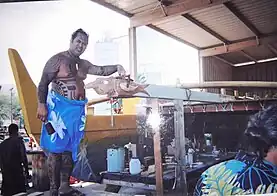



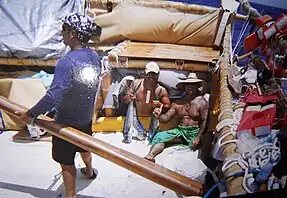



Return to Tahiti
Chief Miko returned to Tahiti in 2008, after more than 25 years in Hawaii. He becomes raatira (leader) of the orero (speakers) of the Heikura Nui troupe. With Heikura Nui, they won two grand prizes at Heiva i Tahiti . Without a written title deed, he chose to settle on the land of his paternal ancestors in Arue, in a traditional bamboo house with a large vegetable garden. There he carved wood and made Tahitian medicines with the medicinal plants he cultivated. On June 24, 2013, the Papeete court ordered his expulsion. Chief Miko must then move into a modern house. It was there that he took on the challenge of making large wooden Tahitian tikis [11] for the Chinese market.[12]
Teroronui Contemporary Creation Center in Papeete
In 2014 Miko joined the CCCTP collective, Center de Création Contemporaine Teroronui de Papeete,[13] a transdisciplinary collective chaired by Jonathan Bougard, whose objective was to work towards the perpetuation of local cultures while supporting the relationship with the means of modern communications.[14] Within this collective Miko finds artists such as Max Tohitika, Julien Magre, Massimo Colombini, Moana Heitaa and the sculptors Pitore and Teva Victor . They exhibited at the Maison de la Culture de Tahiti,[15] Te Fare Tauhiti Nui, then at the University of French Polynesia.[16] According to a text by Jean-Louis Poitevin, “The CCTP intended “ giving the desire for image a central place in the cultural and social life of Tahiti. (...) From tradition to the diffusion of this tradition, from tattooing with a comb to new technologies, this exhibition questions and provides its answers, defines what it means to be an artist today in Tahiti and gives pride of place to artists as well. Polynesians than with offbeat looks.[17]" Beyond the exhibition of paintings, sculptures, Indian inks, happenings and live creations are organized : Chief Miko sculpts live with a chainsaw, then traditional tattoo sessions with a comb, a seminar around these aspects follow.[18]
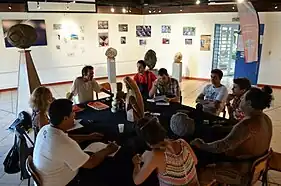
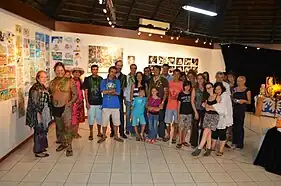
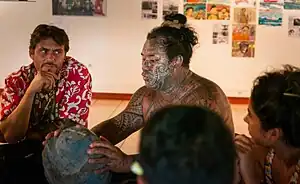
Polynesian Kingdom of Atooi
But Chief Miko is too cramped in this institutional framework. Within the Polynesian Kingdom of Atooi governed by King Aleka [19] he transformed into a real activist, and entered into open conflict with the local and French authorities.[20] He made the headlines of Polynesian news for his outrageous actions such as the occupation and claim of ownership of the Arahurahu marae of Paea, and attracted the animosity of part of the Polynesian population,[21] who does not wish to return to the times of the ancestors.
Videography
Chief Miko features in the documentary Tatau, la culture d'un art, directed in 2014 by Jean-Philippe Joaquim.[22]
In 2017 Chief Miko was the subject of a documentary film co-directed by Jonathan Bougard and Jean-Philippe Joaquim, Miko, le chef voyant.[23]
References
- ↑ "Miko, le chef voyant" (in French). Tahiti Boxing the Mountain. 14 January 2018. Retrieved 16 September 2023.
- ↑ Rédaction la Dépêche de Tahiti, JH (23 September 2013). "CULTURE. Un sculpteur se lance dans l'exportation de ses créations vers l'Asie. Chief Miko exporte ses tiki en Chine". la Dépêche de Tahiti.
- ↑ "Miko le chef voyant". Film documentaire.
- ↑ Jonathan Bougard (14 January 2018). "Entretien avec Chief Miko". Tahiti boxing the mountain (in French).
- ↑ Jonathan Bougard (26 December 2023). "Chief Miko et la navigation traditionnelle". Tahiti boxing the mountain.
- ↑ Makali'i voyaging society. "Nā Kālai Waʻa | Makaliʻi Voyaging Ohana".
- ↑ "Makali'i". Archive.hokulea.com.
- ↑ Patricia Dybman (26 February 2014). "Chief Miko". Les Nouvelles de Tahiti.
- ↑ Jonathan Bougard (26 December 2023). "Chief Miko et la navigation traditionnelle".
- ↑ Mile Gordon (14 November 2006). "New canoe a tribute to Piailug". Honolulu advertiser.
- ↑ "Chef Miko exporte ses tikis en Chine". La dépêche de Tahiti. 23 September 2013.
- ↑ Jonathan Bougard (14 January 2018). "Miko le chef voyant". Tahiti boxing the mountain.
- ↑ Rédaction Tahiti Infos (27 February 2014). "Aujourd'hui à la Maison de la Culture : table ronde sur le thème de la sculpture". Tahiti Infos.
- ↑ Christophe Cozette (26 February 2014). "Bouillon de cultures". La Dépêche de Tahiti.
- ↑ Jacques Franc de Ferrières (28 February 2014). "Une exposition pour favoriser les échages culturels". La Dépêche de Tahiti.
- ↑ Dominique Schmitt (11 September 2015). "Exposition collective "Art Event"". Tahiti infos.
- ↑ Jean-Louis Poitevin (31 August 2022). "Archives du CCCTP. Programme pour une association transdisciplinaire". Tahiti boxing the mountain.
- ↑ Rédaction Tahiti Infos (20 February 2014). "Happening: "Action directe CCCTP" à la salle Muriavai". Tahiti Infos.
- ↑ MARAU BIRET (17 December 2021). "GABRIEL GUINARD PRÊTE SA VOIX AU ROYAUME ATOOI". Radio1.
- ↑ PASCAL BASTIANAGGI (23 September 2020). "LE PKOA EXPULSÉ DU MARAE ARAHURAHU". Radio 1.
- ↑ Gilles Tautu (30 September 2019). "Il s'auto-proclame roi de Tahiti et estime que son permis est valable". polynesie1ere.
- ↑ "Tatau, la culture d'un art". FilmDoc. Retrieved 16 September 2023.
- ↑ "Miko, le chef voyant". FilmDoc. Retrieved 16 September 2023.